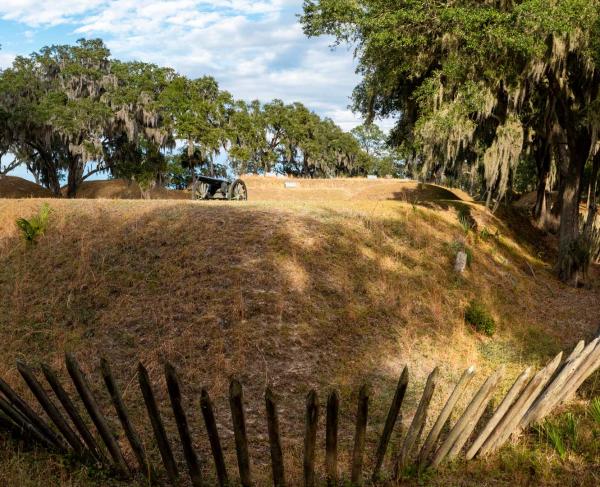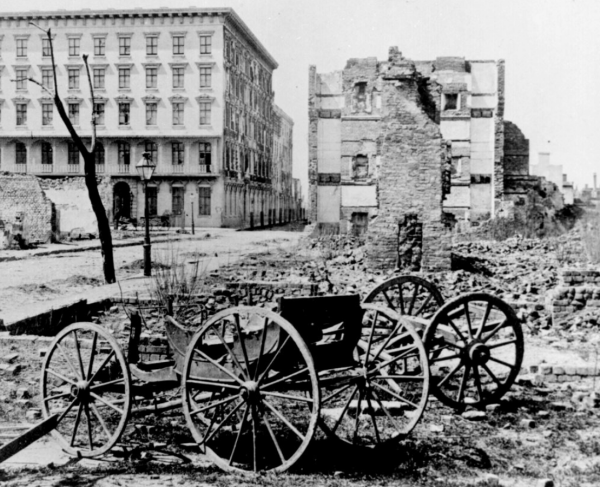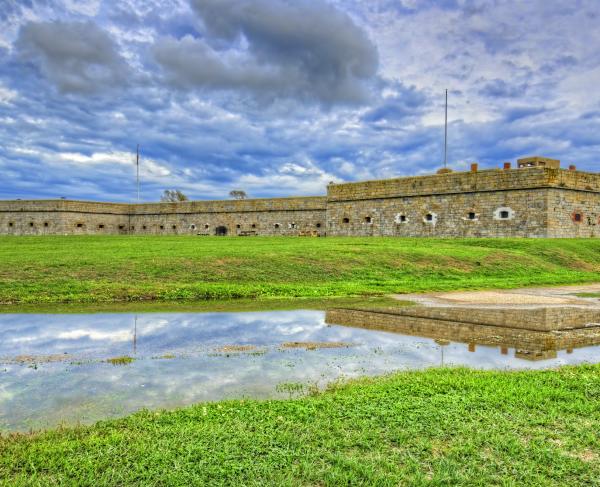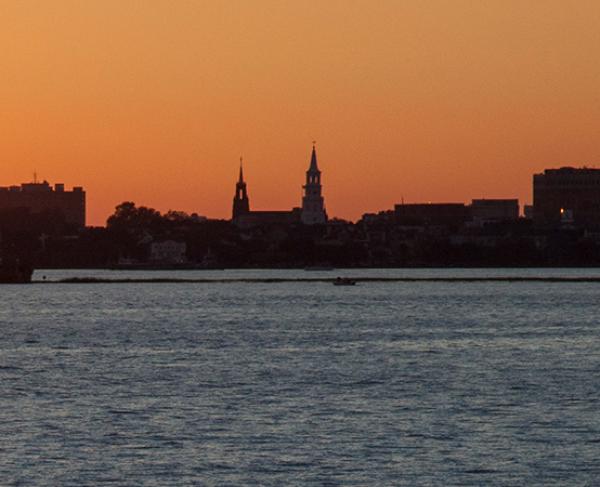Tour Revolutionary Charleston in Two Days
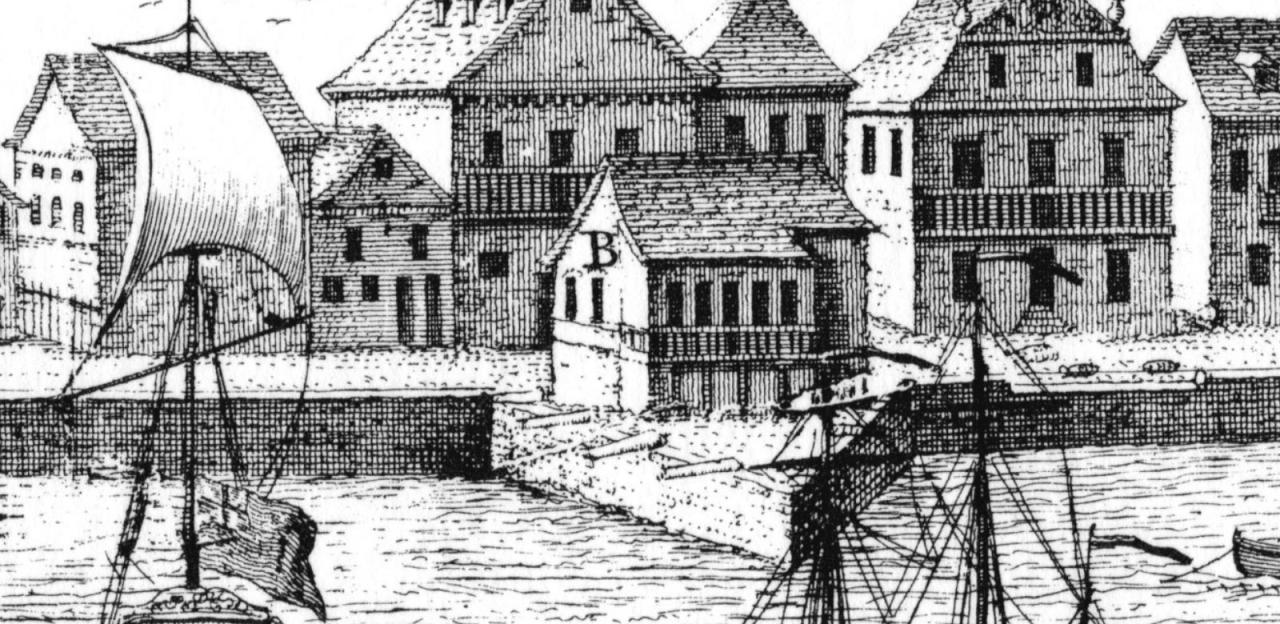
First settled by English colonists in the 1600s, Charleston became one of the largest and wealthiest cities in the American colonies. Modeled after the aristocratic and cosmopolitan atmosphere of restoration London, and named after Charles II of England, Charleston was also known as one of the most beautiful cities in the Americas. Located on the Atlantic coast and at the convergence of several rivers, Charleston became an important center of commerce. Agricultural production of rice and indigo, as well as the importation and trade of enslaved African Americans, supported the city’s early prosperity.
By the 1770s, Charleston had grown to the fourth-largest city in the American colonies. Though some of Charleston’s citizens remained loyal to the Crown, many others were eager to join the Revolutionary movement. In late 1773, Charleston citizens assembled and agreed to seize a tea shipment from the East India Company and store it in the city’s Old Exchange building, protesting the same legislation that brought about the Boston Tea Party in Massachusetts that same year. In 1774, South Carolina sent delegates, elected in Charleston, to the First Continental Congress.
British troops tried to occupy Charleston in 1776 but were repelled at Fort Moultrie. In the spring of 1780, British forces under General Henry Clinton laid siege to Charleston in the first major engagement in the Revolution’s Southern Campaign. After an initial attack, British warships made their way past the defenses at Fort Moultrie, blocking the patriots’ means of escape or reinforcement.
For the next several weeks, Clinton bombarded the city with artillery and heated shot, eventually forcing the Revolutionaries, under General Benjamin Lincoln, to surrender as the city burned. On May 12, more than 5,200 American soldiers were captured, marking the largest surrender in the Revolutionary War.
Although the British succeeded in taking the city and striking a major blow against the Americans, partisan guerrillas led by patriots like Francis Marion, known as the “Swamp Fox,” and Wade Hampton continued to lead raids into the city. The British finally evacuated Charleston at the end of 1782.
Before you go:
- Print or download the Tour Map.
- Watch the Revolutionary War Animated Map.
- Learn more about the Siege of Charleston and the Southern Theater of the Revolutionary War.
Stop #1: The Old Exchange and Provost Dungeon
Time: 1.5 – 2 hours
Details: http://www.oldexchange.org/plan-a-visit
Constructed between 1771 and 1772, the Old Exchange building in Charleston was built as a customs house and assembly hall for the city’s trade economy. The building’s architects, Peter and John Adam Horlbeck, imported materials for the structure, contributing to the structure’s role as one of the first examples of urban planning in the city. During the early years of the Revolutionary War, the building continued to be used as a civic center, providing the location in which South Carolina elected its first delegate to the First Continental Congress. In late 1773, an assembly of Charleston citizens decided to protest the Tea Act by seizing a shipment from the East India Company and storing it in the Old Exchange building until 1776, when it was sold to support the Patriots’ war efforts. In the years after the Revolution, the Old Exchange would serve as the location in which the South Carolinians ratified the newly written Constitution. The Old Exchange’s basement served as a prison for patriots after British forces overtook the city under Sir Henry Clinton in 1780. In 1791, President George Washington spoke from the Old Exchange building during a week-long stay in Charleston. The Old Exchange also hosted a concert and ball to celebrate his visit to the city. Visitors to the Old Exchange can learn more about Charleston’s history, including its role in the Revolutionary War, and the history of piracy.
What to do:
Begin on the Exchange's ground level.
- Pay the admission fee.
- Join a docent-led tour of the building.
Don’t miss:
- Tour each of the building’s levels with a historian/docent to learn more about the history of Charleston.
- View artifacts relating to the history of Charleston, the American Revolution, and piracy.
- Tour the dungeon.
- Learning about George Washington’s visit to Charleston and the soirées that were held in the Old Exchange in his honor.
Stop #2: Heyward-Washington House
Time: 30 mins – 1 hour
Details: https://www.charlestonmuseum.org/historic-houses/heyward-washington-house/
The Georgian-style Heyward-Washington House was constructed in 1772 as a townhouse for Thomas Heyward, Jr., who would sign the American Declaration of Independence in 1774.
What to do:
Start at the House's front entrance.
- Buy tickets in advance to save time. The Heyward-Washington House is maintained and operated by the Charleston Museum, so make sure to purchase a ticket package that includes all of the sites you are interested in visiting!
- Tour the house.
Don’t miss:
- Artifacts and Furniture – The Heyward-Washington House houses a variety of colonial-era furniture, including the well-known Holmes Bookcase.
- Kitchen Building – The Heyward-Washington House is home to the only 1740s era kitchen in Charleston that has been restored for the public.
- Gardens – In addition to the house’s historic architecture and furniture, the property is also home to formal gardens that include plants commonly found in the late 18th century, helping to recreate the South Carolina Low Country of the late 1700s.
Insider tip: Be sure to stop by State House Coffee for a taste of Charleston's coffee scene!
Stop #3: Gibbes Museum of Art
Time: 2 hours
Details: http://www.gibbesmuseum.org/visit/
The Gibbes Museum of Art was opened in 1905 to help Charleston’s longstanding legacy as a city of art to endure. The Museum is now home to a variety of permanent and temporary exhibits, and its collections boast works from some of America’s most famous artists. The Gibbes Museum of Art makes for a great stop if you are interested in learning the story of Charleston’s historical and cultural evolution through artworks.
What to do:
Start on the first floor.
- Buy tickets in advance to save time.
- Check the programs and events calendar before you go.
- View the public gallery on the first floor, and then see the paid exhibits on the museum’s second and third floor galleries.
Don’t Miss:
- 18th and 19th Century American Paintings and Sculpture Exhibit – Be sure to view this permanent exhibit in the museum’s collections to see portraits and paintings from renowned Revolutionary-era artists like Benjamin West and Gilbert Stuart.
- Miniatures Collection – Charleston was home to some of America’s first examples of miniature portrait production, including works from famous American artists like John Trumbull and Charles Wilson Peale. The Gibbes Collection is a great way to visualize life in the 1700s while learning more about this important form of 18th-century portraiture.
Stop #4: Powder Magazine National Historic Landmark
Time: 30 mins – 1 hour
Details: https://www.nps.gov/places/powder-magazine.htm
Established in 1713, the Powder Magazine is one of the oldest public buildings in South Carolina. The structure originally housed the magazine for the city’s gunpowder supplies, used to power the guns and canons that helped Charlestown’s citizens defend the city from Spanish and French invaders, and even pirates. The Powder Magazine is one of the last remnants of the city’s original fortifications. It is now owned by The National Society of Colonial Dames of America in the State of South Carolina. Today, visitors to the Powder Magazine can learn about Charleston’s 18th century history, and the city’s defenses leading up to the Revolutionary War.
What to do:
Start at the main entrance.
- Pay the admission fee.
- Look into booking a tour with one of several sites recommended by the Powder Magazine.
- Check ahead of time for special events and presentations.
Don’t miss:
- Museum Exhibits – The Powder Magazine’s museum and exhibits focus on interpreting Colonial Military History, including the history of the Revolutionary War in Charleston. In addition to traditional displays, the museum also houses several interactive exhibits, models, and a variety of artifacts relating to the colonial period.
- Architecture – Make sure to take a few minutes to look closely at the building’s walls and arches. These original features were designed to help minimize the damage of a powder explosion.
Insider tip: If you're looking for locally inspired, farm-to-table fare, be sure to stop by FIG while touring the downtown Charleston area!
Stop #5: Charleston Museum
Time: 2 hours
Details: https://www.charlestonmuseum.org/visit/museum-information/
Known as “America’s First Museum,” the Charleston Museum was founded in 1773 by the Charleston Library Society. Visitors to the museum can learn about the history of the Lowcountry through a variety of artifacts and exhibits.
What to do:
Start on the ground floor.
- Buy tickets in advance to save time. There are several options for ticket packages, including an option that grants admission to the Heyward-Washington House, so check out the website ahead of time to see which option is the best fit for your visit!
- Check the event schedule for special programs or lectures.
Don’t miss:
- Becoming Americans – Be sure to spend some time in this exhibit, which uses a variety of artifacts to help tell the story of Charleston’s role in Colonial America and the War for Independence.
- The Armory – This exhibit features a variety of historic weaponry, including swords and muskets dating to the American Revolution, and earlier.
- Lowcountry History Hall – In this exhibit, visitors can learn about the Native Americans who inhabited the Charleston area before its settlement by colonists in the 1600s, as well as about the African American slaves who supported the agriculture and business that made Charleston one of the wealthiest colonial cities in America. The exhibit also includes displays on the history of the city’s seaports and surrounding plantations.
If you have time:
- Charleston’s Silver – If you have the time, be sure to explore the Museum’s exhibits on the city’s silver and textile industries.
Stop #6: Battery Park
Time: 1 hour
Details: http://www.dreamcharleston.com/charleston-battery.html
During the Revolutionary War, Charleston's Battery was home to two forts. Also known as White Point Gardens, Charleston's Battery Park is a great place to relax while getting a feel for the city's architecture and history.
What to do:
Visit the park.
- Located across the harbor from Fort Sumter, Battery Park is a great place to enjoy some of the city's most scenic views.
Don't miss:
- Be sure to take advantage of Battery Park's views of Fort Sumter, Castle Pinckney, and the Sullivan's Island Lighthouse across the harbor.
- See the southern mansions along the waterfront.
- Look at the park's cannons and statues.
- Be sure to stroll along the landscaped paths to see the park's variety of flora, including the palmetto trees for which South Carolina is nicknamed.
- Try to stop at the large gazebo, which is one of the park's prettiest and most popular landmarks.
Insider tip: If you are looking for a nice night on the town after a long day of exploring, you might want to check into High Cotton, Magnolias, or Slightly North of Broad (fondly known to locals as SNOB) for a more upscale dining experience!
Stop #7: Fort Moultrie
Time: 1-2 hours
Details: https://www.nps.gov/places/fort-moultrie-visitor-center.htm
Fort Moultrie is made up of a series of fortifications on Sullivan’s Island, South Carolina, just across the harbor from Charleston. Fort Moultrie has served as a defensive system for the South Carolina coastline since the time of the American Revolution. The fort played an important role in Charleston’s defenses during the first British attempt to occupy the city. On June 28, 1776, several British ships attempted to enter the harbor but were repelled by Colonel William Moultrie and his men. The palmetto-log fort was then named in the commanding officer’s honor. The British captured Fort Moultrie during their siege of Charleston in 1780.
What to do:
Begin at the Visitors Center.
- Pay the recreational fee.
- At the Visitors Center, watch the orientation film.
- Check for special programs or events.
Don’t miss:
- Guided Tour – If you can, try to participate in a guided tour of the fort, typically offered at 11:00am or 2:30pm, daily.
- Exhibits on the history of Fort Moultrie – Utilize the Park’s interpretive guides and brochures to explore the fort.
- Public dock, picnic area, and outdoor spaces – Fort Moultrie’s location on Sullivan Island offers a variety of opportunities for nature walks, fishing, viewing wildlife, and observing both Fort Sumter and the city of Charleston across the harbor.
Stop #8: Charles Pinckney National Historic Site
Time: 2 hours
Details: https://www.nps.gov/chpi/planyourvisit/index.htm
Charles Pinckney, often regarded as a “forgotten founder” of the United States, was a prominent South Carolinian who played an important role in America’s early history. Pinckney served four terms as the governor of South Carolina, as well as serving in both the U.S. Senate and House of Representatives. On a national scale, Pinckney was responsible for producing more than 25 clauses in the United States Constitution, as well as serving as Thomas Jefferson’s ambassador to Spain. Located just outside of Charleston, near Mount Pleasant, the Charles Pinckney National Historic Site provides visitors with an inside view of life on a late 18th-century plantation. Snee Farm provided Charles Pinckney’s “country home,” as well as served as a source of income since the property produced rice and indigo with the aid of its enslaved workers. The Charles Pinckney National Historic Site is also one of the locations along the Gullah Geechee Cultural Heritage Corridor.
What to do:
Begin at the Visitor Center.
- Explore the exhibits in the Visitor Center and Museum.
- Check the calendar ahead of time for upcoming events or special programs.
Don’t miss:
- Site Exhibits – Be sure to explore the self-guided exhibits in the Visitor Center and Museum.
- Film Exhibitions – The site offers several short film presentations documenting the history of Charles Pinckney’s life, the Constitution, and the founding of the United States.
- Explore the Snee Farm plantation – Visitors to the park can tour the site of the plantation, and follow a ½ mile trail that includes exhibits on the site’s agricultural history and ongoing archaeological excavations.
Stop #9: Boone Hall Plantation
Time: 2 hours
Details: http://www.boonehallplantation.com/
Established in 1681, Boone Hall is one of the oldest working plantations in American history. Visitors to the plantation can see what life was like in the 17th and 18th centuries, as well as learn more about plantation agriculture since the site still includes a working farm. Like the Charles Pinckney National Historic Site, Boone Hall Plantation is a stop on the Gullah Geechee Cultural Heritage Corridor and offers a variety of opportunities to learn more about the culture of the African Americans who labored in the Lowcountry region of the state.
What to do:
Begin at the main house.
- Pay the admission fee.
- Check for tours or special events taking place on the day of your visit.
- Take a look at the tour options before visiting to make the most of your time at Boone Hall. Tickets include admission to all of the plantation’s tours and events, so make sure to plan ahead so you can catch them all!
Don’t miss:
- House tour – In this 30-minute house tour, you can learn more about the history of Boone Hall Plantation and its residents.
- “Exploring The Gullah Culture” – Check the plantation’s schedule to see if you can attend one of the live cultural presentations.
- Black History in America Exhibit – Visitors can take self-guided tours of nine restored slave cabins on the estate, learning about different aspects of black history through a progression of major themes and events. Slave History Presentations are also available throughout the day as part of the exhibit.
If you have time:
- Plantation Coach Tour – Join the plantation coach tour to see all 738 acres of the estate while learning more about the property’s history and continued legacy.
- Garden Tour and Butterfly Pavilion – See a variety of plants on a self-guided tour of the plantation’s gardens, and then take a walk through the butterfly pavilion, if you’re visiting between May and September.
Insider tip: Check out Hominy Grill for classic Charleston cuisine in a casual setting. Open for breakfast, lunch, and dinner, you can visit this local favorite for whichever meal suits you, although lines can be expected on weekends!
Stop #10: Drayton Hall
Time: 1-2 hours
Details: http://www.draytonhall.org/visit/
Drayton Hall, founded in 1738, is one of the oldest extant plantation houses in America. The hall is one of the earliest examples of Palladian architecture in America. Careful preservation work on the estate has helped to ensure that visitors can see the changes the plantation has undergone over more than 250 years, offering a unique experience.
What to do:
Start at the main entrance.
- Buy tickets in advance.
- Check for special events or programs taking place on the day of your visit.
- Explore all of the plantation’s private and group tour options ahead of time to maximize your time at the estate.
Don’t miss:
- House Tour – Take part in a guided house tour to learn more about the estate, its residents, and the preservation efforts to date.
- Connections Program – This 30-minute program, offered twice daily, helps teach visitors about the experiences of African Americans on the estate.
- African American Cemetery – Visitors to the estate can see a burial ground for African Americans dating back to 1790 or earlier.
Insider tip: If you're looking for classic southern cuisine, be sure to explore Cannon Green's menu. It's one of Charleston's staples. You might also want to check out Husk or The Ordinary for some trendy dining options in charming venues. The Ordinary's location in a 1920s bank makes for a fun (and historic) night out!
Another insider tip: Fenwick Hall Plantation is also worth visiting if you have time. The plantation is not open to the public, however, so if you are interested, be sure to contact the estate in advance to see if a visit would be possible. If you are able to stay a little longer in the city, exploring Middleton Place and Magnolia Plantation and Gardens are also worthwhile! If you're making a trip to the city, be sure to take a look at our itinerary for touring Civil War Charleston, as well!
Related Battles
5,506
258
